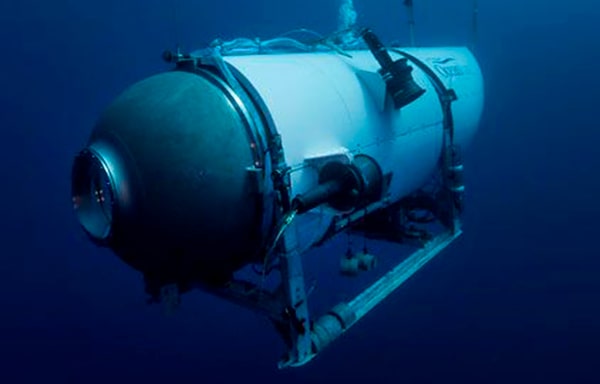
This undated photo provided by OceanGate Expeditions in June, 2021 shows the company's Titan submersible.The Associated Press
A submersible expedition to chronicle the decay of the Titanic wreck has gone missing off the coast of Newfoundland, prompting a massive search operation by U.S. and Canadian authorities to find the vessel and its five crew members.
The Joint Rescue Coordination Centre (JRCC) in Halifax confirmed that a research submersible was reported overdue around 9:13 p.m. Sunday, about 700 kilometres south of St. John’s.
The submersible is operated by U.S.-based OceanGate Expeditions, which brings paying tourists to examine the famous ocean liner that struck an iceberg and sank in 1912. In a written statement the company said it was “working toward the safe return of the crewmembers.“ The submersible dives to a maximum depth of 3,800 metres, the company’s website says.
OceanGate says its vessel was designed with a 96-hour “sustainment capability,” according to Rear Admiral John Mauger, commander of the First Coast Guard District in Boston, which is leading the search. The goal of the operation is to find the submersible within that window, he said during a press conference Monday.
The U.S. Coast Guard has a C-130 Hercules aircraft involved in the search along with a P-8 Poseidon aircraft, which has underwater detection capabilities. Lieutenant-Commander Len Hickey of the JRCC said an Aurora military aircraft and the Canadian Coast Guard vessel Kopit Hopson were assisting the search effort. Rear Adm. Mauger added that sonar buoys capable of searching to a water depth of 13,000 feet were also being deployed.
“It is a remote area and it is a challenge to conduct a search in that remote area but we are deploying all available assets to make sure that we can locate the craft and rescue the people on board,” he said. “What we’re focused on is finding those five people.”
Rear Adm. Mauger said the crew comprised one pilot and four “mission specialists.” OceanGate refers to its paying customers as mission specialists.
British billionaire and explorer Hamish Harding is one of the missing people, a friend told The Globe and Mail. Jannicke Mikkelsen met Mr. Harding on another expedition circumnavigating the world over the north and south poles in a high-speed jet. Ms. Mikkelsen called Mr. Harding “the definition of an explorer.”
She last spoke with him Sunday, wishing him “godspeed” before the launch of the submersible.
Mr. Harding is the chairman of Action Aviation, a United Arab Emirates-based company that sells large aircraft. On Saturday, Mr. Harding posted on social media that he would be going on OceanGate’s expedition as a “mission specialist.”
He said it was likely to be the only mission to the Titanic this year because of an extremely cold winter in Newfoundland. He said the team has “legendary explorers” including Paul-Henry Nargeolet, an expert of the Titanic, who has completed 35 dives to the ship’s wreckage.
In describing its first expedition in 2021, OceanGate said that in addition to archeologists and marine biologists, the expeditions would include roughly 40 paid tourists who would take turns operating sonar equipment and performing other tasks. The initial group was funding the expedition by spending US$100,000 to US$150,000 apiece.
A Newfoundland and Labrador First Nation is part owner of the ship from which the submersible was launched.
“All I can offer at this stage is prayers and more prayers that the people on board will come to the surface and be safe,” Miawpukek Chief Mi’sel Joe said.
Newfoundland and Labrador Premier Andrew Furey tweeted that he is thinking of those affected and hopes the U.S. Coast Guard finds “the sub and those on it very soon.”
The sinking of the “unsinkable” Titanic killed all but about 700 of the roughly 2,200 passengers and crew. Since the wreckage’s discovery in 1985, it has been slowly succumbing to metal-eating bacteria, and some have predicted the ship could vanish in a matter of decades.
According to the OceanGate’s website, its tours are eight-day missions with the money raised by the fees going toward Titanic research.
With a report from The Canadian Press